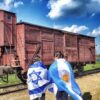-
Son of Holocaust Survivors Helping Jewish Teens Connect with their Heritage
The Boston Globe By Paul E. Kandarian From parents who survived the Holocaust, Irv Kempner, 64, of Sharon, heard firsthand the horrors of 6 million Jews killed by the Nazis in…
Continue reading -
Alumni Reflection: Liz Pearl
By Liz Pearl “Camp is what made me who I am today.” “You can leave camp, but camp can never leave you”
Continue reading -
What Would Miriam Do?
eJewish Philanthropy By Jack Rosenbaum From March to Miriam, an Empowerment Program Offering Light to Holocaust Survivors in Their Twilight Years As the director of the March of the Living…
Continue reading -
March of the Living Makes an Impact on Teens
South Florida Sun-Sentinel By Randall P. Lieberman Daniella Cohen — a senior at Weinbaum Yeshiva High School in Boca Raton — was affected deeply by what she saw on the recent…
Continue reading -
Greetings from Efi Stenzler, Chairman of KKL-JNF
by Efi Stenzler Jerusalem Post April 15, 2015 Every year on Holocaust Remembrance Day, the Keren Kayemeth LeIsrael-Jewish National Fund sends a delegation of employees…
Continue reading -
Alumni From Around the World Look Back at What March of the Living Means for Them
Jerusalem Post By Jerusalem Post Staff The most transformative moments of my trip were those spent with people who endured the horrors of the Holocaust. The survivors’ passion and drive were…
Continue reading -
Remembering the Past, Facing the Future By Phyllis Greenberg Heideman
Jerusalem Post By Phyllis Greenberg Heideman As I reflect on my first March of the Living, I recall the eerie sensation of slowly walking into Auschwitz and timidly passing under the…
Continue reading -
Blind Israelis March from Auschwitz and Birkenau with Their Guide Dogs
Jerusalem Post A 28-minute documentary film, “Blind Love,” recounts a trip in 2013 to Poland of a delegation of six blind Israelis who lead the viewer on a different kind…
Continue reading -
Sigmund Rolat’s Speech in Poland, 2015
Dear March of the Living Students, We have all gathered here to remember. From all sides, we are called upon not to forget. But why should we remember at all? If…
Continue reading -
Playing Music for the March of the Living, Violinist Yevgeny Kutik Writes About March of the Living
Last week, at the invitation of International March of the Living (MOTL), I traveled to Poland to perform at the Holocaust memorial ceremony, held in Auschwitz- Birkenau. In addition to playing at the Auschwitz ceremony, I performed at a concert honoring the liberators who were the first to enter concentration camps and discover Nazi atrocities. I also visited sites around Poland, including the mass graves near Tykocin and the Treblinka concentration camp. As I flew back to the USA, I found that I was at a loss for words. Without a doubt, this was one of the most profoundly moving weeks of my life, yet at the same time I didn’t quite know what to say. Tykocin is a small village in northeastern Poland. Around the time of WWII it was inhabited by 1800 Jewish residents. Over the course of two days, as the Nazis came in, nearly all the residents of this village were taken to the nearby forest and executed in waves. Three pits were dug and the residents were forced to stand in them as they were shot one group at a time, each standing upon the bodies of the previously shot group. The Treblinka concentration camp was responsible for the death of over 800,000 Jews. This camp was designed to execute thousands within hours of arrival. Mass graves and several cremation pits, one of which survives today, were used to dispose of the dead bodies. Upon visiting each of these sites and hearing details of the indescribable subhuman perversity shown by the Nazis, I would find myself go through the same pattern of thought and emotion: shock, a passionate anger and frankly, hate, sadness, and grief. And then suddenly, on the day of the Yom Hashoah ceremony at Auschwitz, I began to experience hope. In preparation for the ceremony I arrived early and walked the length of the overwhelmingly enormous field at the Birkenau death camp to get to a makeshift stage at the other end. An eerie silence filled the space as I quietly walked by myself. After a week of seeing the remnants of Holocaust atrocities first-hand, I was beset by sadness and confusion. After warming up, I stood off in the wings getting ready to open the Yom Hashoah ceremony with music. As I waited, I suddenly saw the first of over 10,000 people start marching onto the field of Birkenau; many of them young, together with Holocaust survivors, veterans, VIP’s, Jews, and non-Jews all walking arm in arm down the same path countless numbers walked to their deaths. This was hope in physical form – the future, understanding, love, and a commitment to good. Inspired, I went out on stage. As at Auschwitz, both at Tykocin and Treblinka, I pulled out my violin and played. At Tykocin I stood by one of the mass graves and played Ravel’s Kaddish (Click here –http://www.youtube.com/watch?v=BCXYPEsDFsQ – to watch performance of Ravel’s Kaddish during the March of the Living.) At Treblinka, I stood by the remaining cremation pit and played Kol Nidre at the site were so many were turned to ash. The sound of music cutting through the quiet, hallowed silence said more than I could ever express with words. (To watch performance of Ravel’s Kaddish at the March of the Living, click here:http://www.youtube.com/watch?v=cd0hCjEs1GI What is there to say? These horrific events happened, and they will forever be burned into our history. All we can do now is always remember what happened and work together to make sure such evil and hate never shows its face again. Never again.
Continue reading




